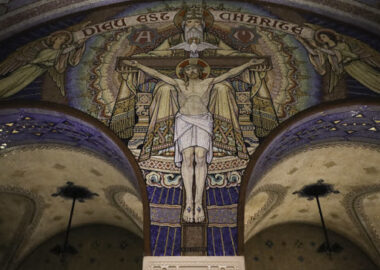
- Home
- Latest Content
- A Piazza and an Apartment
A Piazza and an Apartment
" Saint Teresa of Calcutta watches over her daughters and, in a special way, the poorest of the poor."

by
Br. Thomas Nee, O.P.
on
September 07, 2022
in
Dominicana
Autumn 2016. St. Peter’s Square is lined with tens of thousands of chairs, all of them in use. Chatter permeates the air, and the crowd, armed with umbrellas and folding fans, combats the harsh Roman sun. The congregation is diverse, indicated by the wealth of languages spoken by priests, sisters, and laypeople alike. A brass quartet projects triumphantly into the 17th-century piazza before being replaced by a chorus singing in Latin. The people quiet down as bishops process out of the basilica, and the supreme pontiff himself approaches the broad and imposing altar and incenses it with a deliberate pace and solemnity.
The liturgy continues in many languages, capturing the event’s universality. The crowd looks up to the large image draped on the basilica’s facade. It depicts an old Albanian woman in a white and blue Indian sari—the woman about to be canonized as Saint Teresa of Calcutta.
I, at the time a college junior, found myself in attendance by some fortune. Only beginning to dive deeper into the Catholic faith, I was in awe at the “smells and bells” of the whole experience.
Summer 2022. A small chapel is strewed with a few foldable chairs, some occupied, others not. The air smells of the soup cooking down the hall, and the sound of New York traffic bustles outside. The congregation is diverse—the terminally ill, the homebound, the homeless, and a quintet of women in white and blue saris. An opening hymn is sung in every key all at once, most likely in English, though it is hard to tell. The room quiets and all attention is given to a small wooden altar. Upon it sits a small monstrance with a tiny white host—the King of Kings and Lord of Lords made present in small and unassuming space—given praise, not with incense, but with the silence of the pilgrims who look upon him.
The hour of adoration continues with a rosary prayed alternately by the two uneven sides of the chapel, capturing the event’s intimacy. On the wall of the chapel hangs a small copy of the same image from St. Peter’s six years prior. Saint Teresa of Calcutta watches over her daughters and, in a special way, the poorest of the poor.
I, a Dominican friar, found myself in attendance out of obedience. Now professed in religious vows, I was in awe at the sobriety and dryness of the whole experience.
These two encounters with Mother Teresa represent the life, both earthly and eternal, of a saint. One is of glory, where an abundance of graces are poured out through her intercession, and the whole Church rejoices. But it is only attained through the other, a life of quiet contemplation, with all its discomfort and uneasiness, leaning on the reality of the Lord’s presence with us.
✠
Photo by Plamen Agov (CC BY-SA 4.0)

The Dominican House of Studies
Forming Preachers of Truth in Charity.
Catholic theology in the Thomistic tradition for Dominican students and all who are interested in serving the Church, evangelizing the world, and growing in virtue, wisdom, and holiness.
Give


































